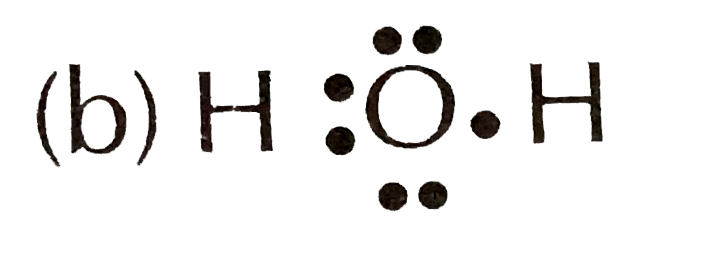The correct electron dot structure of a water molecule is




The correct Answer is:C
To determine the correct electron dot structure of a water molecule (H₂O), we can follow these steps:
Step 1: Identify the central atom
The water molecule consists of two hydrogen atoms and one oxygen atom. Oxygen (O) will be the central atom because it is more electronegative than hydrogen.
Step 2: Determine the number of valence electrons
Oxygen has 6 electrons in its valence shell (as per its electronic configuration: 2, 6). Each hydrogen atom has 1 electron in its valence shell. Therefore, the total number of valence electrons in H₂O is:
- Oxygen: 6 electrons
- Hydrogen: 1 electron × 2 = 2 electrons
- Total = 6 + 2 = 8 valence electrons
Step 3: Draw the electron dot structure for oxygen
We start by drawing the 6 valence electrons around the oxygen atom. This can be represented as:
- 1 dot for each of the 6 electrons:
∙∙∙∙∙∙
Step 4: Add hydrogen atoms
Each hydrogen atom will share its single electron with oxygen. We can represent the hydrogen electrons as crosses (×). When we add the hydrogen atoms, we will show the sharing of electrons:
- For the first hydrogen:
∙∙∙∙∙∙×
- For the second hydrogen:
∙∙∙∙∙∙××
Step 5: Show the shared electrons
Now, we need to indicate that the hydrogen atoms are sharing their electrons with oxygen. After sharing, the structure will look like this:
∙∙∙∙∙∙×∙×
This indicates that oxygen has 2 electrons shared with hydrogen and still has 4 unshared electrons.
Step 6: Finalize the structure
The final electron dot structure of the water molecule shows that oxygen has 4 unshared electrons and is bonded to two hydrogen atoms. The correct representation will show:
- 6 electrons around oxygen (2 shared with hydrogen, 4 unshared).
Conclusion
The correct electron dot structure of a water molecule (H₂O) is represented as follows, where the dots represent the electrons and the crosses represent the shared electrons from hydrogen:
∙∙∙∙∙∙×∙×
Thus, the correct answer is option number 3, which indicates the arrangement of electrons in the water molecule.
---
The water molecule consists of two hydrogen atoms and one oxygen atom. Oxygen (O) will be the central atom because it is more electronegative than hydrogen.
Oxygen has 6 electrons in its valence shell (as per its electronic configuration: 2, 6). Each hydrogen atom has 1 electron in its valence shell. Therefore, the total number of valence electrons in H₂O is:
- Oxygen: 6 electrons
- Hydrogen: 1 electron × 2 = 2 electrons
- Total = 6 + 2 = 8 valence electrons
We start by drawing the 6 valence electrons around the oxygen atom. This can be represented as:
- 1 dot for each of the 6 electrons:
∙∙∙∙∙∙
Each hydrogen atom will share its single electron with oxygen. We can represent the hydrogen electrons as crosses (×). When we add the hydrogen atoms, we will show the sharing of electrons:
- For the first hydrogen:
∙∙∙∙∙∙×
- For the second hydrogen:
∙∙∙∙∙∙××
Now, we need to indicate that the hydrogen atoms are sharing their electrons with oxygen. After sharing, the structure will look like this:
∙∙∙∙∙∙×∙×
This indicates that oxygen has 2 electrons shared with hydrogen and still has 4 unshared electrons.
The final electron dot structure of the water molecule shows that oxygen has 4 unshared electrons and is bonded to two hydrogen atoms. The correct representation will show:
- 6 electrons around oxygen (2 shared with hydrogen, 4 unshared).
The correct electron dot structure of a water molecule (H₂O) is represented as follows, where the dots represent the electrons and the crosses represent the shared electrons from hydrogen:
∙∙∙∙∙∙×∙×
Thus, the correct answer is option number 3, which indicates the arrangement of electrons in the water molecule.
Similar Questions
Write the electron dot structure of CaO
View SolutionDiscuss .the structure of water molecule.
View SolutionWhat would be the electron dot structure of a molecule of sulphur which is made up of eight atoms of sulphur? (Hint − the eight atoms of sulphur are joined together in the form of a ring.)
View SolutionDraw the electron dot structures for
View SolutionWrite the electron dot structures of NaCl .
View SolutionAn element X of group 15 exists as diatomic molecule and combines with hydrogen at 773 K in presence of the catalyst to form a compound, ammonia which has a characteristic pungent smell
(a) Identify the element X. How many valence electrons does it have ?
(b) Draw the electron dot structure of the diatomic molecule of X. What type of bond is formed in it ?
(c) Draw the electron dot structure for ammonia and what type of bond is formed in it ?
View SolutionDraw the electron dot structure of :
[i] Nitrogen molecule [N = 7] , [ii] Sodium chloride [Na = 11, Cl = 17] , [iii] Ammonium ion [N = 7, H = 1 ]
View SolutionDraw the electron dot structure of :
Nitrogen molecule (N=7]
View SolutionDraw the electron dot structure of ammonia molecule and indicate (i) the shared pair of electrons and (ii) lone pair of electrons
View SolutionAn element X of group 15 and period 2 exists as diatomic molecule. It combines with hydrogen and forms ammonia in the presence of a suitable catalyst.
Draw the electron dot structure of the diatomic molecule, and identify and name the type of bond formed.
View Solution
